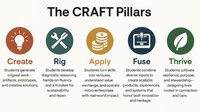The easy part is buying the computers. K-12 is good at that. Every new gadget that comes by, K-12 grabs a bunch: desktops, laptops, netbooks, handhelds (e.g., Palms, PocketPCs, iPads) and now Chromebooks. And what happens after each buying binge? The next buying binge!
At a recent local conference for teachers using educational technology, there was a session with the title: “Hey, I have Chromebooks! Now What?” For grins and a little educator mischief, we changed Chromebooks to iPads and Ms. Google found this: “Hey! I have an iPad! Now what?”. The point? The device might change but the problem remains the same: what do I do with this lovely piece of hardware? Interestingly enough, we found the answer to that question on a blackboard in a study hall for students with detentions <funny smilely-face emoji goes here>:
Schools don’t want technology.
Schools want curriculum.
Schools don’t want technology.
Schools want curriculum.
…
…
Curriculum drives the classroom, not technology. Duh. So, K-12 needs curricula that uses the Chromebooks and, better, demonstrates the value-added of the Chromebooks. Apps that mimic “flash cards” – thin cardboard, rectangular, $1.29 for 800 – do make drill-and-practice more visually interesting, which in turn, may engender their use, and may engender learning – memorization., the lowest form of learning. Fortunately, “ed tech” is way beyond digital flash cards. <Snarky smilely-face emoji goes here.>
And, with each new generation of devices, a pile of books appear to tell teachers how to use that new generation. Indeed, we (Cathie and Elliot) are still proud of our guidebooks for using Palm handhelds and then PocketPC handhelds. And, no surprise, we now have books on how to use the Chromebook in the classroom. (Based on our review of an advance copy, we highly recommend “The Chromebook Classroom.” It will be published in Sept. 2016.)
But here’s the thing: 1-to-1 demands a new generation of curricula. Web Quests were great for that 40 minute period, once or twice a week, in the computer lab/checked out the computer cart. However, if every student has a computing device every period of every day, the Web Quest curricular strategy will get pretty tired, pretty quickly! When the computing device has the ubiquity of paper-and-pencil – and we are getting closer school year after school year – then a different sort of curricula is needed.
First off, the new curricula must be digital so it can be delivered to the children on their computing devices – and avoid the following situation. A 5th grade teacher wrote this on his whiteboard:
Read about heat transfer at tinyurl.com/cdj9ont.
Clearly the teacher didn’t want to write the real URL on the board:
http://www.lowes.com/cd_Understand+Heat+Transfer+and+Insulation_974680410_. But, because the teacher wrote a sentence and wanted to use appropriate grammar, he put a period at the end of the sentence – right after the tinyurl. You can probably guess what happened: half the class put a period after the URL and couldn’t access the website! And gobs and gobs of time was wasted trying to figure out what was wrong. You can’t make this stuff up!
And, while the students are working on their computing devices in groups – since collaborating in real-time is a powerful problem solving technique that educators are promoting – the classroom teacher needs to monitor what each group is doing. Walking around the classroom is one strategy. But it is very handy to be able to interrupt the group work, and hold a whole class conversation while displaying on the whiteboard the work of one of the group’s. We are finding that teachers actually prefer to sit at their desks, participating in the collaborative work by dropping into and out of each of the groups as the students are working, making written comments inside the student group’s artifacts.
In the past, when a student finished an assignment on her/his computer, the student printed it out and handed it in, or emailed it to the teacher. But, when there are dozens of artifacts every week that a student is producing on her/his computing device, those two strategies won’t scale. And, using an app that has a local cloud in which a student’s work is stored won’t scale either. What is a teacher supposed to do – go to that app’s website to find their student’s work – for all the different apps and thus all the different websites and logins and passwords? Nightmare city!
Stepping back, then, if Chromebook uptake (e.g., sales) into K-12 is not going to flatten and fizzle – like the uptake of previous generations of devices, then this new deeply-digital, cloud-based curricula needs to support four activities:
- Create the deeply-digital lessons (localizing where appropriate)
- Distribute the lessons to the groups of students (differentiating when necessary)
- Monitor the enactment of the groups (what about students working on projects outside the classroom?)
- Post-enactment, assess and provide feedback on the student’s artifacts (the quizzes can be automatically graded but the animations, concept maps, etc. require teacher review)
While the following mantra is easy enough to say…
Schools don’t want technology.
Schools want curriculum.
… making it happen is a horse of another color, to say the least!
In Part II of this piece, we will revisit the notion of “deeply-digital, cloud-based curricula” – and explore it… more deeply. Stay tuned!











